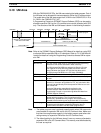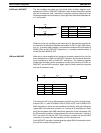
71
3-11 TR (Temporary Relay) Area
The TR area provides eight bits that are used only with the LD and OUT instruc-
tions to enable certain types of branching ladder diagram programming. The use
of TR bits is described in Section 4 Writing and Inputting the Program.
TR addresses range from TR 0 though TR 7. Each of these bits can be used as
many times as required and in any order required as long as the same LR bit is
not used twice in the same instruction block.
3-12 EM (Extended Data Memory) Area
In addition to the high-capacity DM area, C200HG and C200HX PCs are
equipped with an EM area that can store up to 18K-words of data. The EM area
is divided into banks which contain 6,144 words each (EM 0000 through
EM 6143). The C200HG PCs have one bank (bank 0) and the C200HX PCs
have three banks (banks 0, 1, and 2). The effective bank is called the current
bank.
3-12-1 Using the EM Area
The EM area can’t be accessed directly by most instructions, but the PCs are
provided with the EMBC(––), XFR2(––), BXF2(––), and IEMS(––) instructions
to manage EM area data.
Instruction Function
EMBC(––) Changes the current bank to the specified bank number.
XFR2(––) Transfers data within the current EM bank or between the current
EM bank and one of the regular data areas.
BXF2(––) Transfers data between the specified EM bank and another EM
bank or a regular data area.
IEMS(––) Switches the destination of indirect addressing (DM) to the
specified EM bank. Can also switch the destination back to DM.
Example 1 The following example uses EMBC(––) to set the current bank to bank 1 and
XFR2(––) to transfer the contents of EM 2000 through EM 2999 to DM 0000
through DM 0999. After execution of a program section, the contents of
DM 0000 through DM 0999 are transferred back to EM 2000 through EM 2999.
Data processing performed with
data in DM 0000 through DM 0999.
XFR2
#1000
#2000
D0000
EMBC
#0001
XFR2
#1000
D0000
#2000
Note If BXF2(––) were used to perform the data transfers, any EM bank could be spe-
cified and EMBC(––) would not be required to select EM bank 1.
Example 2 The following example uses IEMS(––) to change the destination for indirect ad-
dressing (DM) to EM bank 1. After this instruction is executed, DM operands
EM (Extended Data Memory) Area Section 3-12


















